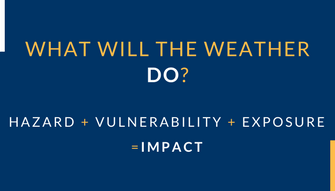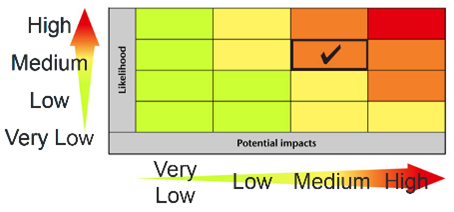By Helen Ticehurst and Nyree Pinder (Met Office), Catalina Jaime (Red Cross Climate Centre), Shristi Vaidya (Deltares), Emily Wilkinson (ODI)
Session leads for Forewarned and Forearmed
Weather and climate information – which predicts conditions days, months, seasons and years in advance – helps governments, businesses and the public make informed decisions to increase their prosperity, enhance wellbeing, and avoid risk.
Forecasting science and skill are constantly evolving. Supercomputers crunch trillions of calculations a second and experts turn weather data from around the world into global forecast and climate models. As their combined ability to process more and more data improves, so will forecast accuracy.
However, even the most accurate forecast has absolutely no value unless it is used to guide decisions that lead to action. This is often the trickiest bit…
Impact Based Forecasting has emerged in recent years as a technique to communicate the impacts weather has on people, their livelihoods and property in order to help decision makers mitigate impacts and prepare effectively for potential emergencies. Essentially, they focus on what the weather will do over what the weather will be.

The type of weather or hazard and the thresholds for action will vary. The core benefit of impact based forecasting is that it involves the user at every point in the design, development and delivery of the forecast. It is a collaborative process incorporating hazard, exposure and vulnerability information to establish what the impact will be. An in-depth risk analysis explores who, when and how people and assets might be affected.

Within the resilience conversation, there is recognition that acting in advance saves lives and money. Predictive capability can be used to support early action through forecast-based financing (FbF), forecast-based action (FbA), shock responsive social protection, and insurance.
Forecast-based financing uses impact-based forecasts to trigger funding to implement early actions in the window of opportunity between the forecast and the potential disaster, which can mitigate risks and prepare for effective response. Thereby, reducing the impact of that shock on vulnerable people, their livelihoods, and health, improving the effectiveness and costs of emergency response and recovery efforts. FbF/FbA mechanisms have a number of characteristics that differentiate them from other anticipatory approaches to reducing the impacts of severe weather and climate events:
- Forecast-based Financing and Action mechanisms strive to link weather and climate forecasts to vulnerability and exposure information as well as other indicators of human wellbeing. While some of these links are obvious, such as the use of flood risk maps, others involve sophisticated analysis and tools such as impact-based forecasts or climate and food security analyses. FbF is a risk-based decision making tool. Since Weather and Climate forecasts are probabilistic, it is critical to communicate the uncertainty of forecasts whilst enabling decision makers to understand the likelihood of an event occurring.
- Forecast-based Financing and Action tools are used to trigger mitigation and preparedness for response actions designed to reduce the impact of climate hazards as they manifest. For example, Forecast-based Financing has been used by the Bangladesh Red Crescent and the German Red Cross to distribute cash before expected floods. In this instance, an impact evaluation showed that early financing helped families avoid using high-interest loans to cover basic expenses whilst preparing for the worst. During El Niño, when the risk of drought is high, The World Food Program, the Zimbabwean Ministry of Agriculture and the Food and Agriculture Organization help farmers switch to drought tolerant crops.
- Forecast-based Financing is proposing a radical shift in Disaster Financing Management to enable funding to be activated based on a forecast. Current Disaster Risk Management systems only enable funding activation for long-term interventions, or after a disaster has already occurred, which unreasonably delays action by governments, humanitarian organizations and communities.
Impact-based forecasting can support these mechanisms to define actions and thresholds for taking action, based on an acceptable level of risk or uncertainty.

National capacity for Impact Based Forecasting must be developed in order to implement national forecast based early action plans. National Meteorological Services (NMS) can be key to this if they position themselves (with government support) as a trusted and authoritative source of weather and climate information. Engaging with users is central to impact-based forecasting, and the NMSs must plan from the start to have the capacity, resources and time to engage users on a continuous basis.
When NMSs, DRR departments, civil contingencies teams, social protection programs, Red Cross Red Crescent societies, NGOs (and many others!), are mandated to work together and share data, meaningful early action can be taken. Cooperation is key to the decision-making process for early action, including understanding who will implement and when. Agencies must agree on how to communicate the uncertainty in forecasts with confidence, consistency and authority.
Impact Based Forecasting and its application in Forecast Based Early Action represents a channel to ensure that advances in forecasting and climate science can translate to actions that can enhance prosperity and save lives.
